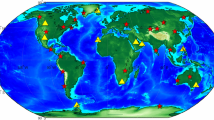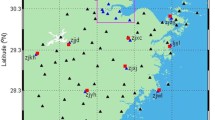Abstract
The impact of precise GPS ephemeris errors on estimated zenith tropospheric delays (ZTD) is studied for applications in meteorology. First, the status of IGS ultra-rapid orbit prediction is presented and specific problems are outlined. Second, a simplified analytical solution of the impact of ephemeris errors on estimated ZTDs is presented. Two widely used methods are studied—the precise point positioning technique (PPP) and the double-difference network approach. A simulation experiment is additionally conducted for the network approach to assess the capability of ephemeris error compensation by the ambiguities. An example of marginal requirements for ephemeris accuracy is presented, assuming the compensation by ZTD only and admitting the error of 1 cm in ZTD. The requirement for the maximum orbit error 1 cm for radial and 8 cm for tangential position components using PPP approach, versus 217 cm (radial) and 19 cm (tangential) using network solution. Furthermore, an assessment of possible compensations of ephemeris errors by other estimated parameters was considered. In radial orbit position, an error of a few meters can be still absorbed by satellite clocks (96%) and phase ambiguities (96%) even for the PPP technique. A tangential orbit position error up to 16 cm for PPP and 38 cm for network solutions should not bias ZTD by more than 1 cm, but any bigger error could, in general. The error impact on ZTD in such cases depends on the compensation ability of ambiguities and clocks (PPP).










Similar content being viewed by others
References
Bar-Sever YE (1996) A new model for GPS yaw-attitude. J Geod 70:714–723
Bevis M, Businger S, Herring TA, Rocken C, Anthes RA, Ware RH (1992) GPS-Meteorology: remote sensing of atmospheric water vapor using the global positioning system. J Geophys Res 97(D14):15787–15801
Dach R, Hugentobler U, Fridez P, Meindl M (2007) GPS Bernese Software, Version 5.0. Astronomical Institute, University of Berne, Berne
Dow JM, Neilan RE, Gendt G (2005) The International GPS Service (IGS): celebrating the 10th anniversary and looking to the next decade. Adv Space Res l36 (3): 320–326
IS-GPS-200D (2004) Navstar GPS Space Segment/Navigation User Interface
Kouba J (2008) A simplified yaw-attitude model for GPS satellites. GPS Solut. First Online
Springer TA, Hugentobler U (2001) IGS ultra rapid products for (near-) real-time applications. Phys Chem Earth Part A 26(6–8):623–628
Zumberge JF, Heflin MB, Jefferson DC, Watkins MM, Webb FH (1997) Precise point positioning for the efficient and robust analysis of GPS data from large networks. J Geophys Res 102(B3):5005–5017
Acknowledgment
The author would like to thank Dr. Jan Kouba from the National Resources of Canada and two anonymous reviewers for stimulating discussions and reading the paper. The work was supported by the Grant Agency of the Czech Republic (205/08/0969).
Author information
Authors and Affiliations
Corresponding author
Rights and permissions
About this article
Cite this article
Douša, J. The impact of errors in predicted GPS orbits on zenith troposphere delay estimation. GPS Solut 14, 229–239 (2010). https://doi.org/10.1007/s10291-009-0138-z
Received:
Accepted:
Published:
Issue Date:
DOI: https://doi.org/10.1007/s10291-009-0138-z




